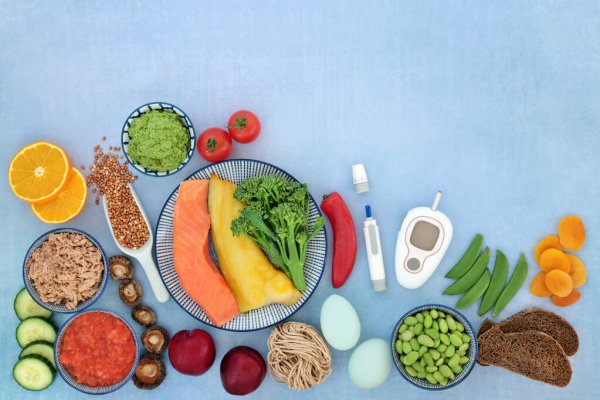Diabetes has grown to “epidemic” proportions, and the latest statistics revealed by the U.S. Centers for Disease Control and Prevention state that 30.3 million Americans have diabetes, including the 7.2 million people who weren’t even aware of it. Diabetes is a potentially life-threatening disease, with complications that can include blindness, stroke, and heart and kidney disease.
Researchers have long maintained that being overweight – which affects a shocking two-thirds of the adult population in the United States – is strongly linked to type 2 diabetes. And, according to experts, every American consumed 152 pounds of sugar and 146 pounds of flour annually, which will develop diabetes by mid-century.
Type 2 diabetes is a dangerous disease that can lead to many other health conditions when it’s not managed properly, this may include leg and foot amputations, nerve damage, blindness, kidney disease, and even death. It develops mostly in adults but is becoming more common in children as the rate at which people are developing obesity rises across all age groups.
Type 2 diabetes is a completely preventable and reversible condition if treated carefully. And with diet and lifestyle changes, you can greatly reduce your chances of getting the disease or reverse the condition.
With a diabetic diet plan, suggested supplements, and increased physical activity, you can quickly regain your health and reverse type 2 diabetes the natural way.
Here are some of the following strategies that can help you prevent, treat, and reverse type 2 diabetes:

Get the Right Nutrients
A healthy diet, physical activity, and maintaining a healthy weight are the first, and sometimes, most important parts of diabetes treatment. If not, a doctor can prescribe medications that can manage blood sugar levels. Along with these treatments, people with type 2 diabetes have tried numerous herbs and supplements to improve their diabetes.
In a combination of proper diet and lifestyle changes, supplements will make cells more sensitive to insulin and better at metabolizing sugar and fat. Several supplements have shown promise as diabetes treatments. These are the minimum recommended doses:
- A high-quality multivitamin and mineral supplement
- 1,000 – 2,000 IUs of vitamin D3
- 200 – 600 mcg of chromium poly nicotinate
- One to two grams of omega 3 fatty acids
- 300 – 600 mg of alpha-lipoic acid twice daily
- 5 to 5 grams of PGX, before meals with 8 ounces of water. This is a unique type of fiber that controls appetite and blood sugar.
Eliminate Sugar
Sugar rapidly spikes blood glucose, and soda, fruit juice, and other sugary beverages are the worst culprits. The consumption of empty calories and quickly absorbed sugar, refined carbohydrates, and liquid sugar calories, these forms of sugar enter the bloodstream rapidly and can cause extreme elevations in blood glucose, causing insulin resistance and Type 2 diabetes. Therefore, you need to eliminate and significantly limit the consumption of sugars, grains, and processed carbohydrates and focus on healthy proteins, fats, and green veggies to lower the risk of type 2 diabetes and obesity.
Eat a Clean Diet
Eating a nutrient-dense diet is another important way to help you. Your diet should be high in:
- nuts
- seeds
- olive oil
- fruits with complex carbs
- vegetables
- healthy fats, like avocado and fish
- legumes
One risk factor for prediabetes is a diet high in processed foods, which have added fats, calories, and sugar without nutritional value. To prevent or reverse diabetes and insulin resistance, you should focus on whole, unprocessed foods. Whole foods stimulate the right gene messages, prevent aging and age-related diseases like heart diseases and diabetes.
The American Diabetes Association recommends a low-carbohydrate eating pattern, however, a low-carbohydrate diet would suggest that you eat the same amount of carbohydrates at each meal — around 45–60 grams — for a total of about 200 grams per day. Some doctors and scientists support a ketogenic diet as a way to lose weight and stabilize blood sugar levels.
However, there are some negative effects of this diet including:
- muscle cramps
- bad breath
- changes in bowel habits
- a loss of energy
- rise in cholesterol level
Reversing type 2 diabetes is possible, but it requires meal planning, healthy eating, and regular exercise. If you can do these things and lose weight, you may be able to free yourself from diabetes and its complications. One product we recommend to help kick start your journey to reverse your type 2 diabetes is Blood Sugar Blaster. You can click the link to watch this amazing story and learn more.

Exercise
Lack of physical activity is another risk factor for type 2 diabetes. And to lower the insulin levels and balance blood sugar, you need to be physically active. All exercise isn’t created equal though and fortunately, smaller amounts of high-intensity exercise have been shown to have a better effect on insulin levels (and weight loss) than an hour of daily moderate cardio. According to the American Diabetes Association (ADA), exercise can reduce blood sugar for up to 24 hours after a workout.
To start exercising, it is important to have a routine for overall health, but before that, you need to talk to your doctor before making a plan and keep the following in mind:
- Start slowly. If you aren’t used to exercising, start small with a short walk. Gradually increase the duration and intensity.
- Walk quickly. Fast walking is a great way to get exercise. A brisk walk is easy to do and requires no equipment.
- Check your blood sugar before, during, and after your workout.
- Keep a snack on hand in case your blood sugar drops while you’re exercising.
Stress raises cortisol and can lead to hormone imbalance, insulin issues, and increases the risk for certain types of disease. There is a direct link between stress, weight gain, mental disorders, and blood sugar imbalances, so it is vital to manage stress to regulate blood sugar and prevent or treat diabetes. Work to reduce your sources of stress from lack of sleep, exposure to toxins, mental and emotional sources, and poor diet. Try yoga, massages, sports, meditations, and deep breathing techniques, laughing, dancing, or walking in nature. Also getting quality sleep every night can help reduce stress hormone levels and is great for blood sugar.
Track your results
To track your results, get a small notebook/journal to keep track of readings and food intake. Start marking your progress in a journal, and write down all information, like body weight, waist size, body mass index (BMI), and blood pressure. Researchers claim that people who measure to track their results lose twice as much weight and do twice as well.



